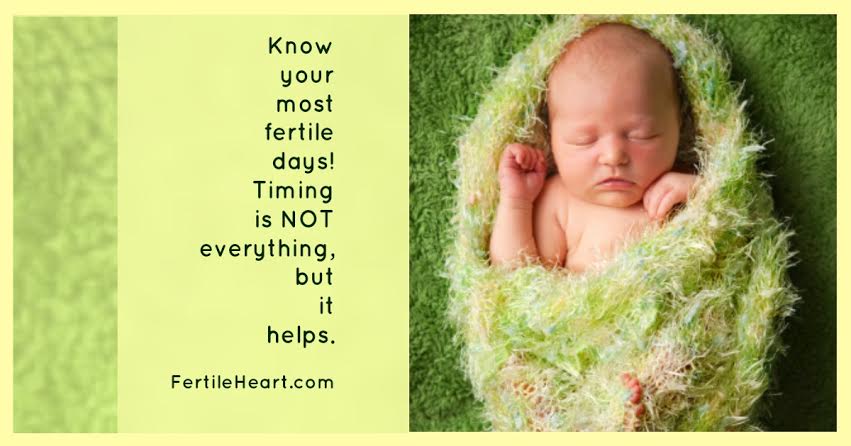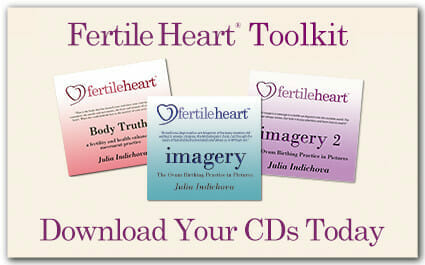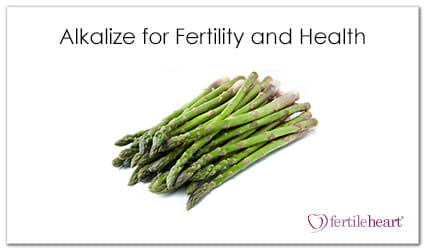 If pregnancy is the destination,
If pregnancy is the destination,
knowing your most fertile day is without a doubt an eminently useful piece of information. In a recent Fertile Heart workshop several women had questions about identifying the most fertile days and the clearest signs of ovulation. Some of them expressed frustration with the level of reliability of ovulation kits.
Ovulation kits can certainly be useful, but there is nothing like learning to know your body.
Inspired by that discussion I thought a brief refresher about the female ovulation cycle and the common signs symptoms of ovulation might be in order.
The Main Event
The essence of our menstrual cycle is to prepare the body for a potential pregnancy. Since we spend so many years of our lives trying to avoid pregnancy when getting pregnant, it takes a bit of doing to shift our focus. In our teenage years, we considered the main event of the female ovulation cycle to be the arrival of our period. But of course the main event of our cycle is, you guessed, ovulation.
Whether or not we become pregnant, depends on many factors, two of which are what happens before and after ovulation.
Two numbers to let go off
Some time ago, I interviewed Toni Weschler, the author of Taking Charge of Your Fertility. One of the first things she said was how important it was to get rid of two numbers: number 14 as the day of ovulation, and number 28 as the duration of a normal female ovulation cycle. I can’t agree more. In my workshops and counseling practice what often happens is that as women begin to use the Fertile Heart™ tools to tune into their inner fertility specialist, they often discover that their production days schedule needs to be adjusted.
Some women ovulate earlier, some later. The ingredients of our Holy Human Loaf have a great deal to do with ovulation.
Some women have shorter cycles others have longer. Having said that, on a physical level, the length of the woman’s cycle can also be a clue to impaired thyroid function, or low progesterone levels, leading to what in medical jargon is known as luteal phase defect. (Learning about specific ovulation boosting foods and herbs could be a helpful step toward repair).
On an emotional level, the length of cycles or annovulation could be a clue to what in the Fertile Heart™ program we call our inner Orphans. I’ve seen women who became annovulatory after a death of a parent or a divorce. The specific imagery exercises on both Imagery Audio Programs and Body Truth Audio are aimed at resolving such issues in our tissues.
Keeping all that in mind, the length of the female ovulation cycle can fluctuate from woman to woman and from month to month.
Identifying your most fertile days
If you can’t rely on general numbers, how do you identify your most fertile days?
Before answering that question, I’d like to clear up the confusion around basal temperature as a symptom of ovulation to look for, when planning your baby making time. The rise in basal temperature happens 2 to 3 days after ovulation. If you wait for your temperature to rise before you make love, you have most likely missed the baby boat. Once the temperature rises, what it means by definition is that the egg has already been released. Since an egg can only live for 12 to 24 hours, by the time the temperature rises, which could be 2 to 3 days later — the egg is gone.
The shift in basal temperature is useful in that it will let you know whether you’re ovulating. You may also want to know the length of time from when your temperature rises until you usually get your period, commonly referred to as the luteal phase The luteal phase needs to be long enough for a fertilized egg/embryo to go from where it was fertilized in the fallopian tubes to the uterine lining, which is about a week or so. And then it could take up to a few more days for the embryo to burrow into the uterine lining.
If the shift in basal temperature is not the indicator for timing intercourse, how do you identify when your ovulation is approaching?
Here is a simple way to think about it: Men produce sperm every day, which is why they also produce a substance, semen, that they are able to release every single day. Semen allows the sperm to live in their body every day. Women on the other hand release one egg, once in an ovulation cycle. And they produce a substance similar to the man’s seminal fluid, around the time when the egg is released.
So when you’re trying to get pregnant, you want to look for a substance that looks very similar to a man’s seminal fluid, which, as we know, looks like egg white: stretchy, clear and slippery. Some women report a perfectly healthy, less stretchy cervical mucus after ovulation, but clear and slippery is a sign to look for.
When trying to get pregnant the idea is to transfer the sperm through this slippery, clear cervical mucus without any break, in order to keep the sperm alive and well. After all it has to make the date with the egg intact.
Ready for take off
Sperm can live on an average three days, but they can actually survive up to five days. That’s why it’s best to have them line up for action before you ovulate. A study published in the Journal of Human reproduction showed that sex the day before ovulation results in the highest number of clinical pregnancies.
Another way to think about it if you’re not trusting an ovulation predictor kit (which is a whole other subject) is that there is always a single day that is more fertile that any other day in the cycle and, that day is the last day of that slippery quality cervical mucus. How do you know when the last day is? You don’t. At least much of the time you don’t. Say, you had this egg white slippery cervical mucus Monday, and you had it on Tuesday. You know the egg must be getting ready for take off. It’s time to slip on that red silky something you got at Victoria’s Secret last month.
Tomorrow you might wake up dry and you’ll be glad you did what was needed the day before. If your cycles are pretty regular and your man needs a little break in between production times, save the love making for the last day. But if your sweetheart is ready and willing then I say have as much fun and as often as your body and heart tells you to.
If production time has become synonymous with failure and tedium and observing the signs symptoms of ovulation fills you with anxiety rather than excitement, the Fertile Couplehood post might be fun to peruse as you prepare to light the flame that feeds the baby dream.
If this is your first visit with us, WELCOME and don’t forget to sign up for our newsletter and receive a free e-book that might shift your view of what’s possible for you!
@2012 Julia Indichova and Fertile Heart No portion of this document may be reproduced without permission from the copyright holder.
A special thank you to Toni Weschler, the author of the wonderful book, Taking Charge of Your Fertility for her input for this article.










